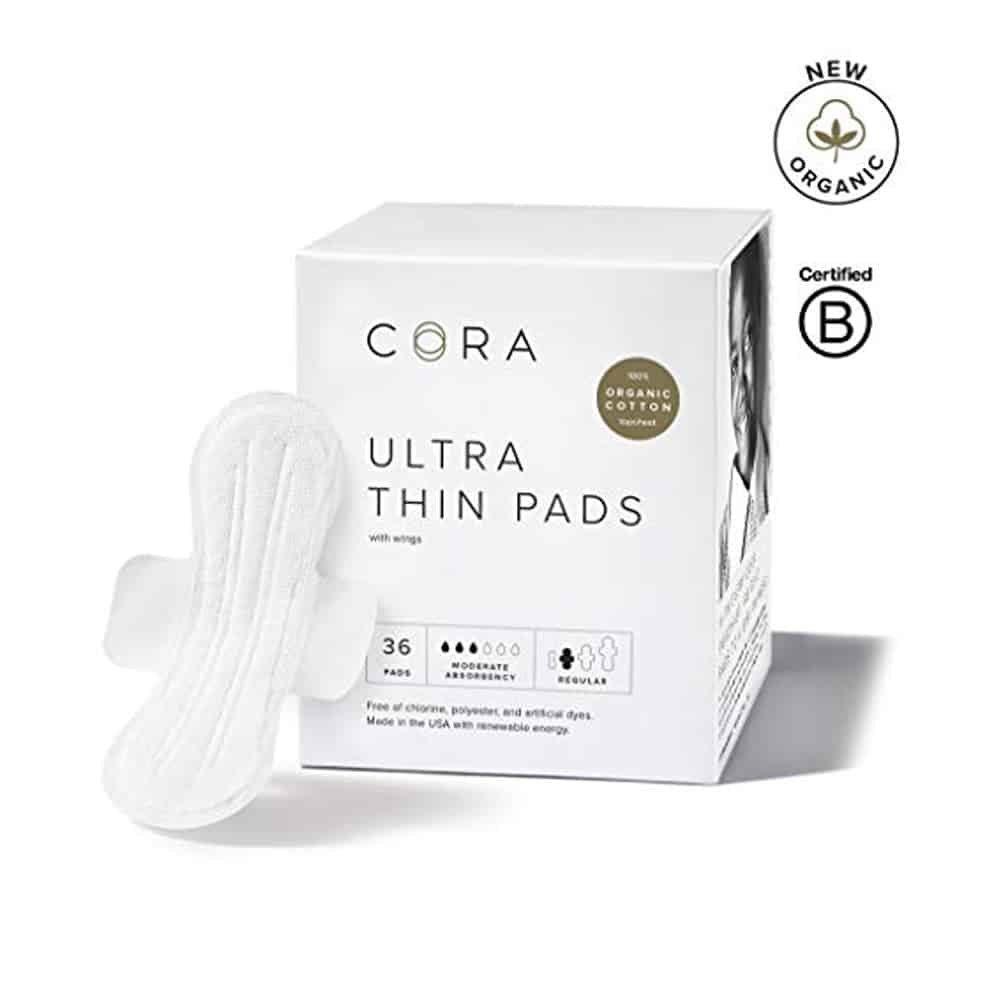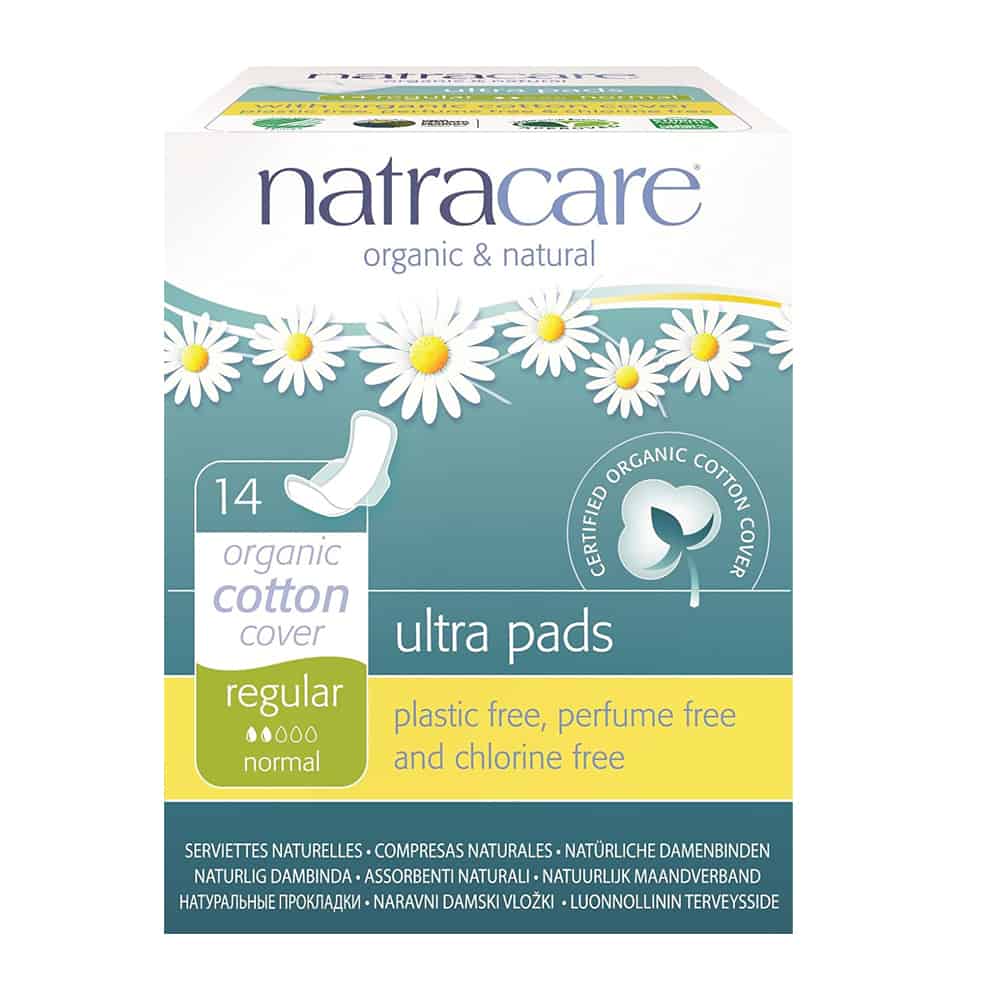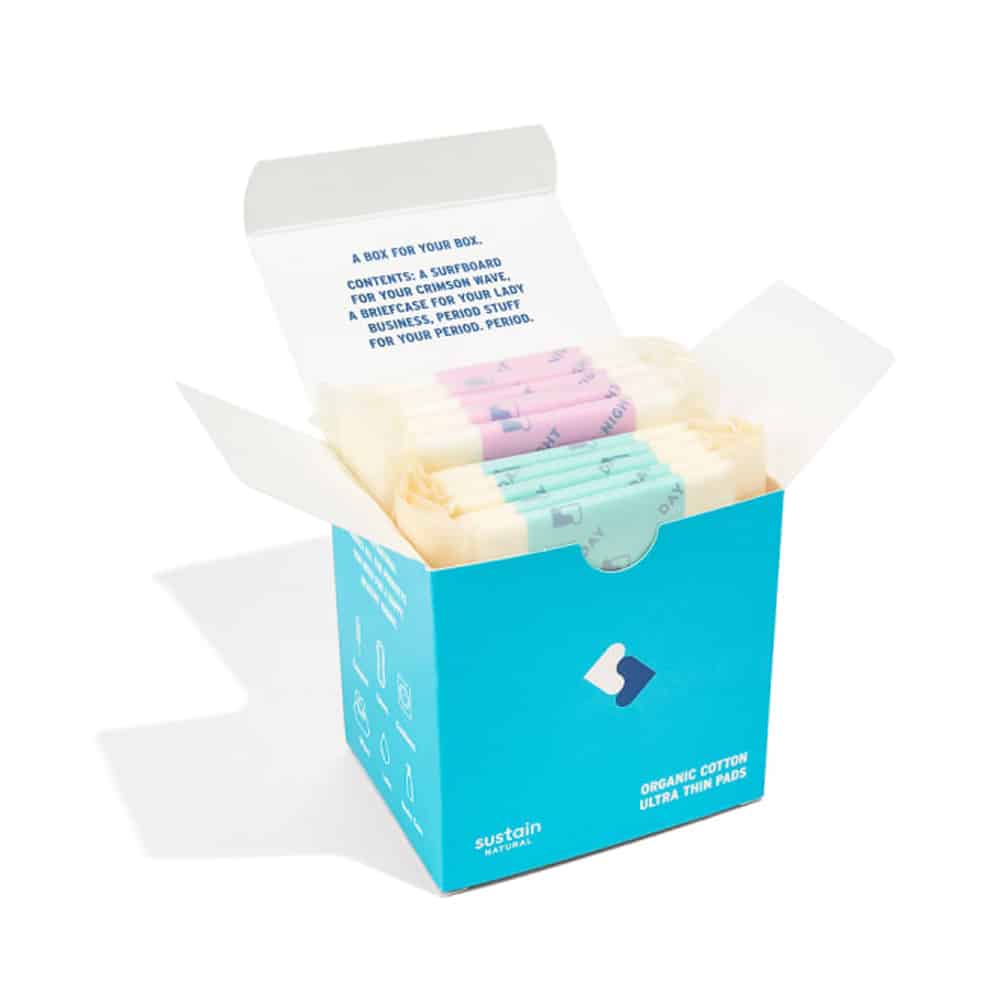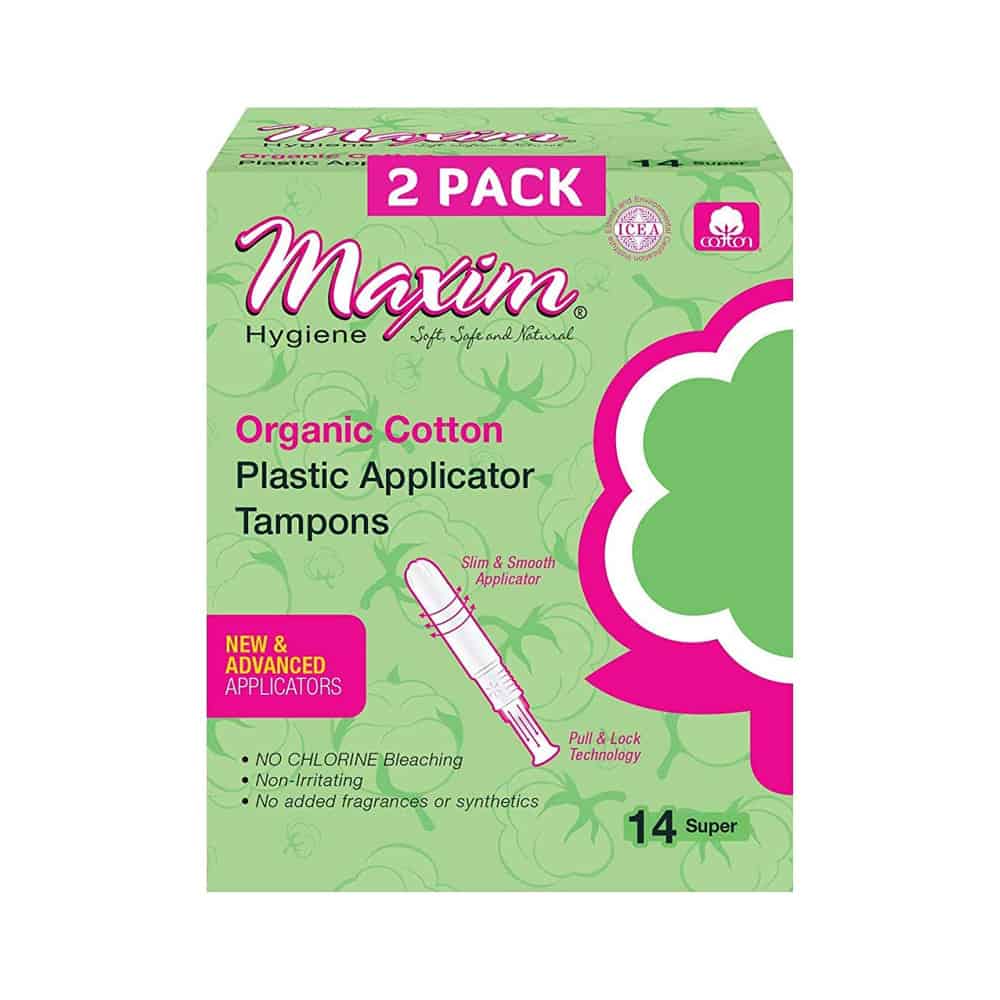Make The Switch To Organic Cotton Period Pads
Switch to organic cotton pads for a healthier, greener option that’s better for you and for the planet. Avoid harmful chemicals in conventional period pads and make the switch to 100% organic cotton pads.
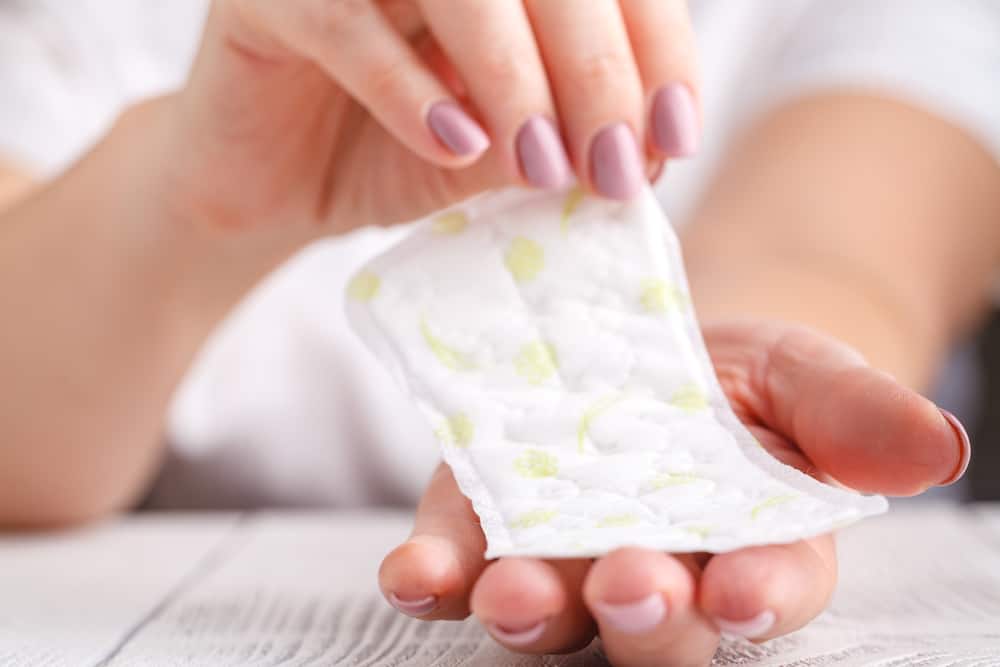
Disclosure: This post contains affiliate links, which means if you make a purchase through these links, we may receive a small commission at no extra cost to you.
With 3 out of 4 people in our household menstruating (myself and my two teenage daughters), we go through A LOT of period pads every month. And if you stop and think of all the pesticides and chemicals that conventional pads contain, that’s a lot of unnecessary exposure.
Pads and tampons come into direct contact with the highly permeable skin of the vaginal area, which can be a direct route of chemical exposure for menstruating women (1).
Since pads and tampons are regulated as medical devices, manufacturers aren’t required to list all of the ingredients (with the exception of New York State—New York is the first state to require ingredient labels on menstrual products).
It turns out conventional pads and tampons contain a laundry list of potentially toxic chemicals. Most women wear pads and/or tampons for approximately one week, once a month throughout their entire reproductive lives (excluding pregnancy)—that’s about 7 years!
This chronic exposure over time to chemicals in pads and tampons may be harmful to a woman’s health. It’s crazy how little research has been conducted on the health impacts of chemical exposure from these products! Below are some of the studies that have been conducted on the harmful chemicals in menstural pads:
- In a 2019 study, researchers tested 11 brands of sanitary pads and found two types of pthalate chemicals and three types of Volatile Organic Compounds (VOCs) in the products tested (2).
- The organization Women’s Voices of the Earth analyzed Always pads for Volatile Organic Compounds (VOCs). The pads had measurable levels of styrene (a carcinogen), chloromethane (a reproductive toxicant), chloroethane (a carcinogen), chloroform (a carcinogen, reproductive toxicant and a neurotoxin) and acetone (an irritant) (3). That’s upsetting and disturbing!
- Have you seen the video by Naturally Savvy? In the video, Andrea sets fire to two period pads (I love that this women is willing to torch period pads!) She set fire to an Always pad and a Natracare organic cotton pad. The Always pad had a strong flame with thick black smoke. The smoke had a stinky, toxic smell to it, and the foam core of the pad melted and stuck to the glass bowl. The Natracare pad burned slow and clean. The flame wasn’t black, and the smoke didn’t have a toxic smell to it.
Conventional Pads & Tampons May Contain These Harmful Ingredients
- Pesticide residue from non-organic cotton. Cotton is the world’s most heavily sprayed crop. If your pads or tampons aren’t 100% organic cotton, chances are the cotton has been sprayed with pesticides. Seven of the 15 pesticides commonly used on cotton in the United States are listed as “probable” or “known” human carcinogens by the Environmental Protection Agency (4).
- Dioxins– Dioxins are a byproduct of the chlorine bleaching process, and have been associated with reproductive issues (5). Pulp is now most commonly bleached with an elemental chlorine-free (ECF) process. Although chlorine bleaching was phased out in the 1990’s, a Women’s Voices study found traces of dioxins in tampons tested after this phase out (6).
- Phthalates– Phthalates are used to soften plastics in products such as cosmetics, toys, medical devices and other plastics. A conventional period pad contains up to 5 plastic bags worth of flexible plastic. Phthalate chemicals in the plastic have been linked to a variety of health concerns including endocrine disruption, impacts to reproductive systems (including birth defects), and some forms of cancer (7, 8). As mentioned above, in a 2019 study on sanitary pads, researchers found two types of phthalate chemicals in all of the 11 brands of sanitary pads tested. The measured phthalate levels in the products tested were significantly higher than what is commonly found in plastic goods (9).
- Synthetic fragrance– Fragrance can irritate sensitive skin and cause allergies and other adverse reactions. The Right To Know report (10) on fragrance ingredients presents data on the chemicals in fragranced beauty, personal care and cleaning products. These chemicals are linked to cancer, birth defects, endocrine disruption and other adverse health effects. Synthetic Fragrance may contain carcinogens, endocrine disruptors, allergens, respiratory irritants and neurotoxic chemicals (11). Synthetic musks like galaxolide and tonalide, are linked to hormone disruption (12). Fragrance is also an often unrecognized source of phthalate exposure, which are hormone disruptors (13).
- Rayon– Rayon is a derivative of wood and non-organic cotton, which is often exposed to pesticides and bleach. Also, carbon disulfide is used in the production of rayon. Exposure to carbon disulfide among rayon manufacturing workers has been associated with menstrual disorders and reproductive effects (14,15).
- Volatile Organic Compounds (VOCs) are used as dissolving agents in the plastic manufacturing process, and one conventional period pad contains up to 4 plastic bags worth of flexible plastic. Researchers in the 2019 study found the following VOCs in the sanitary products: methylene chloride in two brands of sanitary pads; toluene in nine; and xylene in all 11 brands tested (16). In a separate study conducted by Women’s Voices, some brands of tampons contained methylene chloride, a carcinogen commonly found in paint strippers (17).
There’s More To An Organic Cotton Pad Than Meets The Eye
There are now a plethora of choices on the market for organic cotton period pads and tampons, and I’m so glad for that! However, there are varying materials and characteristics that distinguish each brand from every other brand. With that in mind, I came up with ten categories to help you determine what product most closely matches what’s most important to you. Does cost drive you, company mission, a certified organic cotton absorbent core, a biodegradable wrapper, or maybe all of the above?
All of the brands I’m reviewing have 100% certified organic topsheets. That’s important, since the topsheet is the material closest to your skin. The ten categories I found information for are as follows: concerning ingredients the product is free from, topsheet material, backing material, absorbent core material, adhesive, wrapper material, where the product is made, cost per 1 regular winged pad*, pad sizes offered and the company mission.
How did I find all of this information? I started with the brand website, where I collected as much information as possible from the product page and the FAQ page. I was also able to collect information from the back of each box of pads. For missing information, I emailed each company with questions, and was happy to get answers back from all companies but one (I decided not to include that brand).
*Cost was calculated at the time this article was published, and is subject to change.
What To Look For In Organic Pads And Tampons
- 100% certified organic cotton
- Unscented or fragrance free
- Unbleached cotton
- Plastic free applicator for tampons
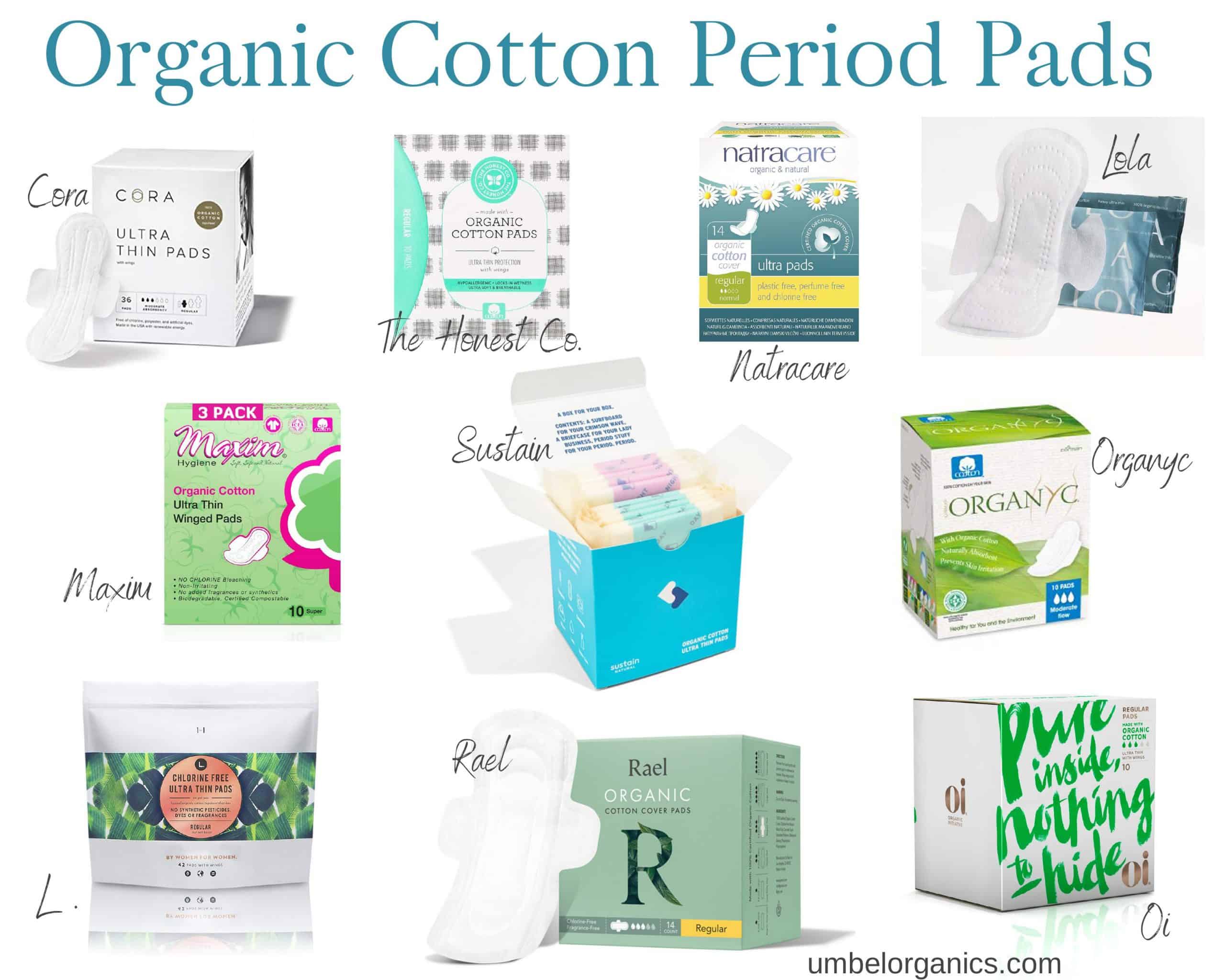
- Free From: Plastic, perfumes, dyes, chlorine, GMOs

- Topsheet: 100% certified organic cotton
- Backing: Plant starch
- Absorbent core: Ecologically certified cellulose pulp
- Adhesive: Non-toxic
- Wrapper: Biodegradble (domestic compostable)
- Pad sizes: Ultra with wings (regular, long, super, normal extra, super extra, long extra), pads without wings (regular, super plus ultra, super maxi, nighttime maxi), liners (curved, mini, tanga for thongs, ultra thin, normal, long)
- Cost: $0.19 per regular winged pad
- Made in: Europe
- Company mission: Donate 1% for the Planet. This means we partner with non-profits and charities to help give back to our Earth. Below are just some of the amazing organisations we work with: Marine Conservation Society (MSC), Women Engage for a Common Future (WECF), 5 Gyres, Turning Green, Plastic Pollution Coalition
Oi Certified Organic Cotton Pads
- Free From: Chlorine bleaching, synthetics such as rayon and polypropylene, toxic chemicals, dyes, fragrances and lubricants
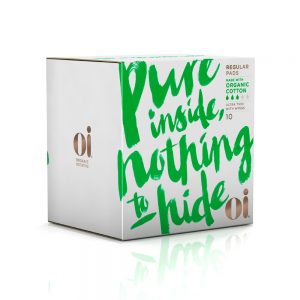
- Topsheet: 100% GOTS and BioGro certified organic cotton
- Backing: Biodegradable cornstarch
- Absorbent core: 100% certified organic cotton
- Adhesive: Non-toxic
- Wrapper: Biodegradable bioplastic wrapper
- Pad sizes: Ultra thin liners, ultra thin pads with wings (regular, super)
- Cost: $0.65 per regular winged pad
- Made in: Europe, Israel, New Zealand and China
- Company mission: Oi has a “Change your world this month” campaign to educate women about how to make simple changes, for good.
The Honest Company Organic Cotton Pads
- Free From: Rayon, polyester, fragrances, deodorants, artificial dyes, phthalates, pesticide residues, chlorine, chlorine dioxide processing, SAP, ethanolamine, diethylhexyl adipate, acetone, chloroethane, chloroform, chloromethane, or acetophenone.

- Topsheet: 100% GOTS certified TCF organic cotton
- Backing: Plant-based polymer
- Absorbent core: 100% GOTS certified TCF organic cotton
- Adhesive: Unknown (I contacted the company and they did not have this information)
- Wrapper: Polymer (90%+bio-based)
- Pad sizes: Ultra-thin with wings (regular and super), liners
- Cost: $1.00 per regular winged pad
- Made in: Italy
- Company mission: Honest has partnered with Baby2Baby to help provide diapers, clothing and basic necessities to low-income children across the US.
Organyc 100% Certified Organic Cotton Pads
- Free From: Chlorine bleach, latex, parabens, perfumes, SAP, and plastics or man made materials

- Topsheet: 100% certified organic cotton
- Backing: Mater-bi (cornstarch-based)
- Absorbent core: 100% certified organic cotton
- Adhesive: Confidential (specific for hygiene products)
- Wrapper: Mater-bi (cornstarch), which is environmentally friendly
- Pad sizes: Light panty liners (6 inches), extra long maxi panty liners (6.5 inches), light plus panty liners, overnight pads, moderate day pads (9.3 inches), heavy night pads (10.5 inches)
- Cost: $0.71 per regular winged pad
- Made in: Italy, cotton from USA
- Company mission: Not found on website
Rael Certified Organic Cotton Pads
- Free From: Fragrance, chlorine, artificial dyes, GMOs, acetone, styrene, chloroform, chloromethane, rayon, polyester and pesticides

- Topsheet: 100% certified organic cotton from Texas (OCS and non-GMO)
- Backing: Polyethylene (PE), Polypropylene (PP)
- Absorbent core: Chlorine-free natural wood pulp, Super Absorbent Polymers (SAP)
- Adhesive: Non-toxic
- Wrapper: Biodegradable
- Pad sizes: Regular pads with wings (3″ W x 9.6″ L), overnight with wings (3.1″ W x 12.5″ L), large with wings (3.1″ W x 11″ L), petite with wings (3″ W x 9″ L), regular liner (2″ W x 6″ L), long liner (2″ W x 6.8″ L)
- Cost: $0.53 per regular winged pad
- Made in: USA and South Korea
- Company mission: For every photo shared on Instagram with the hashtag #HappyPeriodsForAll, Rael will donate a period product to a woman in need. Rael supports Los Angeles- based women that are homeless, low-income, and or/living in poverty and provides them with menstrual hygiene kits..
Cora Ultra Thin Organic Cotton Period Pads
- Free From: Chlorine, polyester, artificial dyes, fragrance, rayon, dioxins, chloroform, pthalates and latex
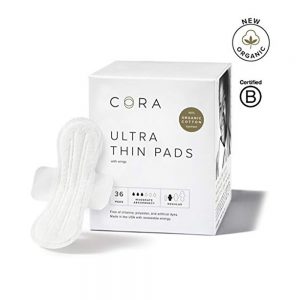
- Topsheet: 100% certified organic cotton
- Backing: Polypropelene
- Absorbent core: Plant-based materials (chlorine-free wood pulp) and a non-toxic super absorbent polymer (SAP) layer
- Adhesive: ethylene copolymer (hot melt adhesive)
- Wrapper: Polyethylene
- Pad sizes: liner (regular, long), Regular with wings, super with wings, overnight with wings, maximum overnight with wings
- Cost: $0.63 per regular winged pad (18 count box)- for 36 count box, $0.44 per pad, for 72 count box, $0.39 per regular winged pad)
- Made in: Europe and China
- Company mission: With every Cora purchase, we provide pads and health education to a girl in need (India, Kenya, USA). We use the power of business to fight for gender equality and provide products, education, and jobs to girls and women in need in developing nations and right here at home.
Maxim Ultrathin Organic Cotton Pads
- Free From: Toxins, dyes, additives, chlorine bleach, fragrance, synthetics
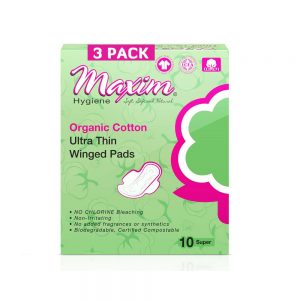
- Topsheet: 100% GOTS and ICEA certified organic cotton
- Backing: Breathable & Compostable Natural Fiber Back Layer
- Absorbent core: 100% certified organic cotton
- Adhesive: Non-toxic
- Wrapper: Unknown
- Pad sizes: Ultra thin winged regular, ultra thin contour, ultra thin wrapped liners, ultra thin classic panty liners, ultra thin 2-in-1 lite liners, contour light flow liners
- Cost: $0.65 per regular winged pad/ $0.52 on amazon
- Made in: Unkown
- Company mission: Woman-led company
Shop Organic Cotton Period Pads


Choose Organic Cotton
When it comes to farming, conventionally grown cotton is heavily sprayed. Here are some environmental reasons to buy organic cotton pads and tampons:
- Keep our waterways free from harmful herbicides and pesticides.
- Encourage pollinators to visit crops, and keep the bees, butterflies and birds safe from harmful chemicals.
- A conventional pad contains up to 5 plastic bags worth of flexible plastic, which can take hundreds of years to break down.

More Natural Living Inspiration

References
- Scranton, A. Potential Health Effects of Toxic Chemicals in Feminine Care Products. Women’s Voices For The Earth. November 2013.
https://www.womensvoices.org/wp-content/uploads/2013/11/Chem-Fatale-Report.pdf - Chan Jin Park, A. et al. Sanitary pads and diapers contain higher phthalate contents than those in common commercial plastic products. Reprod Toxicol. 2019 Mar; 84: 114–121.
https://www.ncbi.nlm.nih.gov/pmc/articles/PMC6504186/ - Always Pads Testing Results. Women’s Voices of The Earth.
https://www.womensvoices.org/menstrual-care-products/detox-the-box/always-pads-testing-results/ - Cubie, Doreen. Cotton and Pesticides: Pick Your Cotton. The National Wildlife Federation. Feb 01, 2006.
https://www.nwf.org/en/Magazines/National-Wildlife/2006/Cotton-and-Pesticides - Dioxins
https://www.niehs.nih.gov/health/topics/agents/dioxins/index.cfm - Scranton, A. Potential Health Effects of Toxic Chemicals in Feminine Care Products. Women’s Voices For The Earth. November 2013.
https://www.womensvoices.org/wp-content/uploads/2013/11/Chem-Fatale-Report.pdf - Patisaul, H.B. and Adawele, H.B. Long-Term Effects of Environmental Endocrine Disruptors on Reproductive Physiology and Behavior. Front Behav Neurosci. 2009; 3: 10.
https://www.ncbi.nlm.nih.gov/pmc/articles/PMC2706654/ - Radke, E.G. et al. Phthalate exposure and male reproductive outcomes: A systematic review of the human epidemiological evidence. Environ Int. 2018 Dec;121(Pt 1):764-793.
https://www.ncbi.nlm.nih.gov/pubmed/30336412 - Chan Jin Park, A. et al. Sanitary pads and diapers contain higher phthalate contents than those in common commercial plastic products. Reprod Toxicol. 2019 Mar; 84: 114–121.
https://www.ncbi.nlm.nih.gov/pmc/articles/PMC6504186/ - Nudelman, J. and Engel, C. Right To Know. Exposing toxic fragrance chemicals in beauty, personal care and cleaning products. Breast Cancer Prevention Partners and Campaign For Safe Cosmetics. Sept. 2018.
https://d124kohvtzl951.cloudfront.net/wp-content/uploads/2018/09/26092837/BCPP_Right-To-Know-Report_Secret-Toxic-Fragrance-Ingredients_9_26_2018.pdf - Synthetic Musks. Campaign For Safe Cosmetics. A Project of Breast Cancer Prevention Partners.
http://www.safecosmetics.org/get-the-facts/chemicals-of-concern/synthetic-musks/ - Sheffer, Jane. New Tampon Testing Confirms Need For Ingredient Disclosure. Women’s Voices of the Earth. June 2018.
https://www.womensvoices.org/2018/06/05/new-tampon-testing-confirms-need-for-ingredient-disclosure/ - Carbon disulfide
https://www.epa.gov/sites/production/files/2016-09/documents/carbon-disulfide.pdf - Chan Jin Park, A. et al. Sanitary pads and diapers contain higher phthalate contents than those in common commercial plastic products. Reprod Toxicol. 2019 Mar; 84: 114–121.
https://www.ncbi.nlm.nih.gov/pmc/articles/PMC6504186/ - Sheffer, Jane. New Tampon Testing Confirms Need For Ingredient Disclosure. Women’s Voices of the Earth. June 2018.
https://www.womensvoices.org/2018/06/05/new-tampon-testing-confirms-need-for-ingredient-disclosure/









